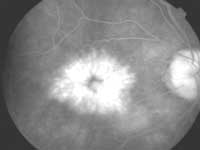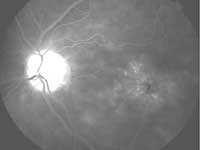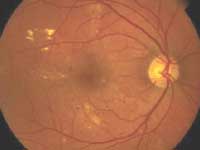Understanding cystoid macular edema
OSN’s new monthly column, Corneal Health, will feature a practical discussion on the prevention and treatment of corneal and external disease.
Click Here to Manage Email Alerts

Eric D. Donnenfeld, MD: Cystoid macular edema is something that we have all seen, and it unfortunately can occur with routine cataract surgery. In the past we would look for the classic petaloid appearance of the fovea. Our criteria for cystoid macular edema are changing dramatically now, and there is a new understanding of it.
Please give us the current view of cystoid macular edema as compared to what it was a few years ago, and tell us how this affects the comprehensive cataract surgeon.
Kerry D. Solomon, MD: If you think about our definition of clinically significant cystoid macular edema (CME) from 5 or 10 years ago — or possibly even 1 or 2 years ago — it was clinical signs and symptoms of decreased vision associated with angiographic CME. Simply the presence of angiographic CME in and of itself was not felt to be clinically significant.
 Eric D. Donnenfeld |
I use an analogy to LASIK. If a LASIK patient comes in on day 1 postop with 20/30 or 20/40 vision, what do we do? We look at the patient’s ocular surface. We look at the patient’s flap. We take a topography to see if there is a little irregular astigmatism. We are trying to continue to raise our outcomes to achieve earlier visual recovery and 20/25 vision.
If we have a cataract patient with 20/40 vision on postop day 1, we tell them, “You are doing great.” But the reality is that using the new standard in technology, optical coherence tomography (OCT), with angiographic CME we can document retinal thickening on virtually every case. And when CME resolves — angiographic, mild retinal thickening or otherwise — it is often associated with the development of epiretinal membrane formation.
As we raise the bar for our outcomes, looking beyond Snellen acuity and contrast sensitivity, we need to avoid angiographic CME, especially in today’s era of presbyopic lenses. We must get out of the angiographic definition and move on to a tighter definition. Any retinal thickening documented by OCT is going to be playing a role with modern surgery. It is common without the use of topical nonsteroidal anti-inflammatory drugs before surgery.
 Kerry D. Solomon |
The time to use NSAIDs is preoperatively, before the release of prostaglandins. If you start them at the time of surgery or postoperatively, the door is already open.
In data I recently heard, the incidence of use of NSAIDs with presbyopic IOL implantation was not quite 100%, but it was high. If we are using that standard of care for patients who are receiving presbyopic IOLs, we ought to be using that same level of care for all of our cataract patients. We said at a forum a year ago that the use of NSAIDs surrounding routine cataract surgery would be the coming standard of care.
Dr. Donnenfeld: I would suggest to all of you who are starting your NSAIDs 1 day or less before surgery that you will be better cataract surgeons if you start your NSAIDs 2 or 3 days preoperatively. You will have better results. The surgery will be faster. You will have less pupil surprises if you start more than 1 day preoperatively.
Dr. Solomon: The main reason for using NSAIDs preoperatively is not for inflammation and cell and flare in the anterior chamber; it is really CME prophylaxis. We do not want any reduction of contrast sensitivity. If we are putting a presbyopic lens in, we cannot afford to have any.
Frequency of CME
Dr. Donnenfeld: How common is CME with cataract surgery?
Calvin W. Roberts, MD: It depends what your definition of CME is. Terry O’Brien put it precisely in saying that, in the past, we used to talk about angiographic CME vs. clinical CME, and today we know that all CME is clinical.
 Calvin W. Roberts |
It all depends upon what your benchmark is for measuring. Two benchmarks for measuring outcomes are the quantity of vision and the quality of vision. Snellen acuity is a measurement of quantity of vision. Other instruments like contrast sensitivity are a measurement of quality of vision. While you may have small amounts of CME and still have 20/20 vision — thus a normal quantity of vision — all cases of an increase in macular thickness will lead to a decrease in quality of vision, and that is not always reversible. By decreasing contrast sensitivity, the small amounts of macular edema that occur postop are going to permanently affect outcomes.
When we talk about how common CME is, the question begins with how common it is to have small amounts of macular edema still present after 1 month. The answer is that it’s all dependent upon what your pharmaceutical regimen is. In the absence of using NSAIDs, to have small amounts of macular edema afterward is common. It may not affect quantity of vision, but it will affect quality of vision. I think that in patients who start out with normal maculas and use NSAIDs, that number can get close to zero.
High-risk patients
Dr. Donnenfeld: We all agree that starting NSAIDs preoperatively is important, but as surgeons we are all asked to address the high-risk patients. Some patients may have greater risk of CME after cataract surgery. What do you do differently for a patient who has a florid background diabetic retinopathy background? Is there anything you can do differently, either preoperatively or postoperatively, for these patients?
 Francis S. Mah |
Francis S. Mah, MD: The first thing that you have to do is tell the patients that that they are in a high-risk category for macular edema. I start the NSAID topically a week before the surgery. We give them samples to start before the surgery and tell them to use the eye drops 1 week before.
We write prescriptions for the patients to get the eye drops after surgery for at least 3 months because the peak incidence of CME is around 6 weeks after the procedure. You want to cover these high-risk patients through that high-risk period, but you also want to make sure that they are not going to have any CME afterward.
My steroid regimen does not change much. I prescribe four times a day for a week and then twice a day for another week.
Dr. Donnenfeld: So you think NSAIDs are more important in preventing CME than steroids?
Dr. Mah: Definitely.
Dr. Donnenfeld: Does anyone have any significant differences in their postoperative treatment?
Terry Kim, MD: Jeff Heier’s work showed a nice synergy of steroids and NSAIDs, so I continue the steroids in high-risk patients. For patients with diabetes, I send them to a retina specialist to be evaluated for the possible need for laser or other treatment. But with patients who are at high risk for CME, I am more aggressive with steroid therapy and also give them NSAIDs for at least 2 to 3 months postoperatively.
Dr. Donnenfeld: There are some people who would prescribe them for more than 3 months.
Dr. Kim: Three to 6 months, depending on their response and resolution of CME on OCT.
Dr. Donnenfeld: And depending upon how bad the previous eye was.
Dr. Kim: High-risk factors for CME are important to identify. I like to divide these high-risk characteristics into two categories: patient factors and surgical factors. If the patient has a history of diabetes, uveitis, epiretinal membrane, retinitis pigmentosa, any kind of retinal vascular diseases like branch retinal vein occlusion or central retinal vein occlusion or a history of ocular surgery or previous CME, I consider them to be at a higher risk for developing CME.
 Terry Kim |
In terms of surgical risk factors, you may have a patient who requires a larger incision or a prolonged operative time. Perhaps it is a patient with whom you encounter intraoperative floppy iris syndrome (IFIS) or for whom you have to perform synechialysis or pupil stretching. Cases involving rupture of the posterior capsule, vitreous loss, retained lens cortical material and even cases of toxic anterior segment syndrome (TASS) are certainly included in this category. All of these surgical risk factors warrant a longer duration of topical NSAID therapy — possibly for 3 to 6 months — to protect against CME.
Patients with epiretinal membrane
Dr. Solomon: We do not want to underestimate epiretinal membranes. Cal, can you tell us about the findings from the OCT study that you did?
Dr. Roberts: Because of studies that we were doing, we were routinely doing preop OCTs on patients. One day my technician came in, showed me a preop OCT and said, “You know, this looks different than the other patients.” Sure enough, this patient had a little epiretinal membrane. I looked at the patient again by slit lamp with my 90° lens, and I really did not see the epiretinal membrane.
It turns out that now, in more than 2,000 patients, we have come up with a 6% incidence of small epiretinal membranes in eyes that are otherwise fine. What we have found is that patients with the small epiretinal membranes that were hard to detect preop are the patients who are at the greatest risk of having less than optimal outcomes after surgery.
Now, we have gotten into the habit of doing preop OCTs on all patients. It is a screening technique, so we do not charge the patient; however, it dramatically decreases the incidence of surprise outcomes where the patient has normal surgery, normal recovery and then 1 month later is only seeing 20/40 or 20/50 and wants to know why they are not seeing well. It turns out they had an epiretinal membrane.
When we are able to detect these epiretinal membranes preop, we change the whole dynamic of the relationship. I show the epiretinal membrane to the patient and explain what the possible outcome could be. Now they are involved, and they ask me on each postop visit, “How is that thing doing? Am I going to have a problem?”
I must tell you — and this is a statistic that sounds incredible, but it is true — that in these last 2,000 cataract patients, we have not had a single case of CME in a patient who did not have a preoperative epiretinal membrane.
|
|
|
Images: Donnenfeld ED |
Dr. Solomon: Your work has changed the way we practice. We are doing the same thing, and I am floored because we see it all of the time, much more than I thought we would. It changes my regimen because, if I see this, then I am going to have a different conversation with the patient. I am going to start them earlier on the drops, and we are going to keep them later and longer to look for CME.
For patients who are asking about a ReSTOR (Alcon), a ReZoom (Advanced Medical Optics) or crystalens (eyeonics), I now tell them that I do not think they are ideal candidates. It is affecting my decision-making, as far as those who I may feel would be good candidates for presbyopic lenses. It has changed the way we approach routine cataract patients.
Dr. Donnenfeld: I think that we all owe a debt of gratitude to Cal for pointing out the importance of these epiretinal membranes. OCT has changed the way I practice ophthalmology as well, and it speaks to the importance of our technology now. It used to be the physical examination, the clinical examination, which was so important. Now, with tools like OCT, we can diagnose things much earlier and much finer and be much more accurate than we have ever been before.
For more information:
- Eric D. Donnenfeld, MD, is a cornea specialist in private practice at Ophthalmic Consultants of Long Island and co-chairman of Cornea and External Disease at Manhattan Eye, Ear and Throat Hospital. He can be reached at Ryan Medical Arts Building, 2000 North Village Ave., Rockville Centre, NY 11570; 516-766-2519; fax: 516-766-3714; e-mail: eddoph@aol.com. Dr. Donnenfeld is a consultant for Advanced Medical Optics.
- Kerry D. Solomon, MD, can be reached at Medical University of South Carolina, Storm Eye Institute, 167 Ashley Ave., Room 221, P.O. Box 250676, Charleston, SC 29425; 843-792-8854; fax: 843-792-6347; e-mail: solomonk@musc.edu. Dr. Solomon is a consultant for Alcon, Allergan, Advanced Medical Optics and Bausch & Lomb.
- Calvin W. Roberts, MD, can be reached at 1300 York Ave., Box 61, New York, NY 10021; 212-734-7788; fax: 212-734-4476; e-mail: rroberts@bcm.tmc.edu. Dr. Roberts is a consultant for Allergan.
- Francis S. Mah, MD, can be reached at University of Pittsburgh Medical Center, Eye and Ear Institute, 203 Lothrop St., 8th Floor, Pittsburgh, PA 15213; 412-647-2200; fax: 412-647-5119; e-mail: mahfs@upmc.edu. Ocular Surgery News could not confirm whether Dr. Mah has a direct financial interest in the products mentioned in this article or if he is a paid consultant for any companies mentioned.
- Terry Kim, MD, can be reached at Duke University Eye Center, Erwin Road, P.O. Box 3802, Durham, NC 27710-3802; 919-681-3568; fax: 919-681-7661; e-mail: terry.kim@duke.edu. Dr. Kim has no direct financial interest in the products mentioned in this article. He is a paid consultant for Alcon, Allergan and Ista Pharmaceuticals.
Reference:
- Heier JS, Topping TM, Baumann W, Dirks MS, Chern S. Ketorolac vs. prednisolone vs. combination therapy in the treatment of acute pseudophakic cystoid macular edema. Ophthalmology. 2000;102:2034-2038.




